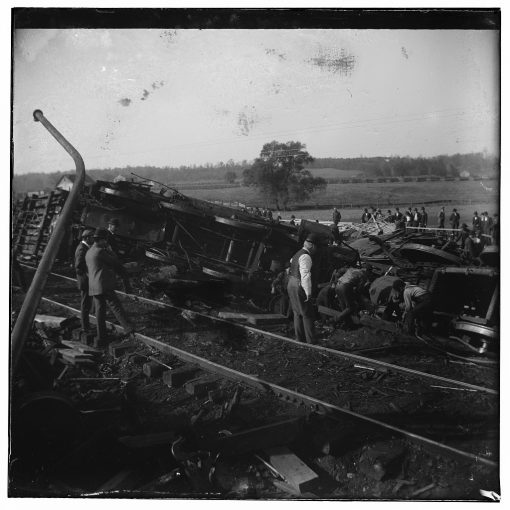The Wright Brothers’ Early Photography: A Research Note
Casey Huegel
Ohio History
The Kent State University Press
Volume 123, Number 1, Spring 2016
pp. 73-87
10.1353/ohh.2016.0007

On October 20, 1897, at 12:30 P.M. on a rural stretch of land roughly three miles south of Dayton, Ohio, the southbound Toledo and Cincinnati Express train no. 1 and the northbound Freight no. 30 of the Cincinnati, Hamilton, and Dayton Railroad Company collided in an “earthquake crash,” violently shaking the passengers on board. Luckily for the commuters onboard the express train, the Cincinnati, Hamilton, and Dayton Railroad Company was transporting an empty baggage car from a Lima workshop to Cincinnati for use by the Indianapolis division of the company. Connected between the engine and the passengers, the empty car almost certainly absorbed impact that would have been inflicted tenfold on the unsuspecting travelers. The Dayton Journal reported that “it seems a positive miracle that a dozen or more persons were not killed.”1 There was at least one man of the cloth who endured the wreck with the nearly forty-car freight, and that was Bishop Milton Wright—the controversial and seasoned member of the Church of the United Brethren in Christ—better known later in his life as father of Wilbur and Orville Wright, inventors and first pilots of the airplane in 1903.
In typical Bishop Wright fashion he wrote a terse diary entry describing his unusual day. The bishop wrote: “Fail to get onto the 8:15 train. After an early dinner, I take the C. H. & D. train for Indianapolis and two miles below Dayton, our locomotive collides with a freight train, demolishing each [End Page 73] and destroying six or eight cars. Several were bruised, and the engineer was thrown under the locomotive [and] died some days later. Mrs. Betty Frederick of Kingston, Ross Co., Ohio was badly hurt.”2 Arriving at the scene of the crash to photograph the mangled steel and scattered cargo were Wilbur Wright (April 16, 1867–May 30, 1912) and Orville Wright (August 19, 1871–January 30, 1948). Two four-by-five-inch photographic negatives survive to offer a glimpse of this fascinating, and until now, untold story of the train wreck and their father’s near demise.3 Besides the obvious motive for Wilbur and Orville to visit the train crash site to check on the status of their father, there are a few clues that match the story in the bishop’s diary to the photograph. First, the Dayton Journal reported that passenger train engineer William Mathers was pinned under the freight after reportedly leaping from the train before the crash, corroborating Wright’s account. The Dayton Journal also described that the wreck occurred “right in the middle of the open stretch” between the Eby and Nicholas farms. The background of one photograph (LC-W85-61) clearly illustrates farmland, matching the scene of the accident to the newspaper’s account. In front of the gathering crowd in the rear of the photograph is also a pile of lumber, which north-bound Freight no. 30 was carrying as its primary cargo, along with cottonseed flour, baled cotton, lampblack, and pig iron.4 The last piece of evidence is in another photograph (LC-W85-60) depicting the front of the mangled train. To the very left of the image one can see the s in Express, which was the name of the passenger vehicle described in the accident.
Over three hundred images are contained in the Wright Brothers Negatives collection, which was donated to the Library of Congress as a part of the Wright brothers’ papers in 1948. While researching the exhibit, The Photography of Wilbur and Orville Wright, 1897–1900, to be installed at Dayton Aviation Heritage National Historical Park, it became clear that despite the extensive publications on the Wrights, few scholars have considered the limited contextual information and inconsistencies surrounding their early photography. Like the train-wreck photographs, many lacked complete identifications, begging for a close photographic study to piece together these stories. Photography was a vital tool the Wrights used to document the developmental process of the airplane, so it is critical to examine [End Page 74] the brothers as amateur photographers to better understand Wilbur and Orville as respected experimenters in aeronautics…
